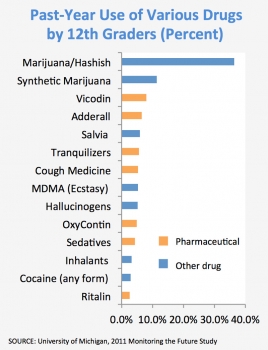DrugFacts: High School and Youth Trends
Revised July 2012
Every year, the Monitoring the Future (MTF) survey measures drug, alcohol, and tobacco use and related attitudes among 8th, 10th, and 12th graders. Following are facts and statistics about youth substance use from the 2011 MTF report.
Illicit Drug Use
Illicit drug use among teenagers has been rising, largely due to increasing popularity of marijuana. Marijuana use by adolescents declined from the late 1990s until the mid-to-late 2000s, but has been on the increase since then. In 2011, 7.2 percent of 8th graders, 17.6 percent of 10th graders, and 22.6 percent of 12th graders used marijuana in the past month, up from 5.7 percent, 14.2 percent, and 18.8 percent in 2007. Daily use has also increased; 6.6 percent of 12th graders now use marijuana every day, compared to 5 percent in the mid-2000s.
Rising marijuana use reflects changing perceptions and attitudes. Historically, as perception of risks goes down, use goes up (and vice versa). Young people are showing less disapproval of marijuana use and decreased perception that marijuana is dangerous. The growing perception of marijuana as a safe drug may reflect recent public discussions over medical marijuana.
Synthetic marijuana is a new and major concern. Also known as Spice or K2, synthetic marijuana refers to herbal mixtures laced with synthetic cannabinoids, chemicals that act in the brain similarly to THC, the main active ingredient in marijuana. These mixtures could be obtained legally until recently and are still wrongly perceived as a safe alternative to marijuana. Synthetic marijuana was added to the MTF survey in 2011. In that year, 11.4 percent of 12th graders—one in nine—reported using it in the past year.
Nonmedical use of prescription and over-the-counter medicines remains a significant part of the teen drug problem. In 2011, 15.2 percent of high-school seniors used a prescription drug nonmedically in the past year. Data for specific drugs show that the most commonly abused prescription drugs by teens are the pain reliever Vicodin and the stimulant Adderall.
Positive trends in the past several years include reduced use of inhalants and less use of cocaine, especially crack cocaine. Past-year inhalant use by younger teens dropped significantly between 2010 and 2011, from 8.1 percent of 8th graders and 5.7 percent of 10th graders to 7.0 percent and 4.5 percent, respectively. Past-year use of crack cocaine by 12th graders dropped from 1.4 percent to 1.0 percent. Other drugs, such as heroin, methamphetamine, and hallucinogens, are holding fairly steady.
Ecstasy (MDMA) use is seeing a resurgence among older teens. Past-month use of ecstasy by 12th graders increased from 1.4 percent in 2010 to 2.3 percent in 2011. This may reflect the fact that, like marijuana, ecstasy is no longer considered as dangerous as it once was. From 2005 to 2011, the percentage of 12th graders who said that trying ecstasy once or twice would be risky dropped from 60.1 percent to 49.0 percent.
Alcohol
Alcohol use among teens has dropped to historically low levels. In 2011, 4.4 percent of 8th graders, 13.7 percent of 10th graders, and 25 percent of 12th graders reported getting drunk in the past month, continuing a downward trend from previous years. Significant declines include sharp drops from previous years in daily alcohol use by 10th and 12th graders (0.8 percent and 2.1 percent, respectively, in 2011). In 2011, 21.6 percent of high-school seniors reported binge drinking (defined as 5 or more drinks in a row in the past 2 weeks)—a drop of almost one-third since the late 1990s.
Tobacco
Fewer teens now smoke cigarettes than smoke marijuana. Cigarette smoking by high-school students peaked in 1996–1997 and has declined continuously since then. In 2011, 11.7 percent of students surveyed by MTF were current (past-month) cigarette smokers—the lowest teen smoking has been in the history of the survey. By comparison, 15.2 percent were current marijuana smokers.
Other forms of smoked tobacco are becoming popular, however. The use of hookah water pipes and small cigars has raised public health concerns and has recently been added to the MTF survey. In 2011, 18.5 percent of 12th graders had smoked a hookah at some point in the past year, and 19.5 percent had smoked a small cigar.
Learn More
Complete MTF survey results are available at www.monitoringthefuture.org. For more information on the survey and its findings, also visit www.drugabuse.gov/related-topics/trends-statistics/monitoring-future.
Other sources of information on drug use trends among youth are available:
The annual National Survey of Drug Use and Health, conducted by the Substance Abuse and Mental Health Services Administration, gathers detailed data on drug, alcohol, and tobacco use by all age groups. It is a comprehensive source of information on substance use and dependence among Americans aged 12 and older. Data and reports can be found at www.oas.samhsa.gov/NSDUHLatest.htm.
The Youth Risk Behavior Survey is a school-based survey conducted every other year by the Centers for Disease Control and Prevention. It gathers data on a wide variety of health-related risk behaviors, including drug abuse, from students in grades 9–12. More information is available at www.cdc.gov/nccdphp/dash/yrbs/index.htm.
About the Survey
Since 1975, the MTF survey has measured drug, alcohol, and cigarette use and related attitudes among 12th graders, nationwide. In 1991, 8th and 10th graders were added to the survey. Survey participants report their drug use behaviors across three time periods: lifetime, past year, and past month. Overall, 46,733 students from 400 public and private schools in the 8th, 10th, and 12th grades participated in the 2011 survey.
The survey is funded by NIDA and conducted by the University of Michigan. Results from the survey are released each December.






